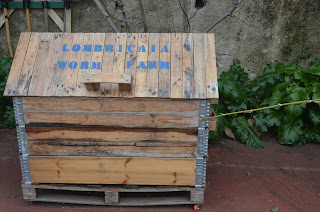In Canada community gardens are usually what are called allotments in Britain.
The Orti dipinti are actually a series of teaching gardens.
They belong to the community and are staffed by volunteers, but the purpose is not to offer garden plots to the public. It is rather to teach about gardening, especially to school children and the people at an handicapped center next door.
The plants, mostly vegetables and herbs, are grown in raised beds. To teach water conservation, most of the watering is done by burying clay containers which release the water very slowly. Some of the containers have decorative tops, no doubt made by the children.
There is a lot of regular composting
and vermiposting
as well as shelters for insects.
The nasturtiums in the container below must be part of a display on companion planting
and these wine bottles have been transformed into containers.
There has been a lot of playing with clay. It seems that each of the students who visited, left a memento.
This being Florence, this community garden is not in an out-of-the-way corner where there happens to be some vacant land, but in what used to be part of the garden of the Palazzo Salviati.
Half of the area is used as a public park.
Below is the entrance gate, just beyond the guardian's little hut. The building across the road is the Four Season Hotel (with the Gherardesca Garden).
The Orti dipinti are actually a series of teaching gardens.
They belong to the community and are staffed by volunteers, but the purpose is not to offer garden plots to the public. It is rather to teach about gardening, especially to school children and the people at an handicapped center next door.
The plants, mostly vegetables and herbs, are grown in raised beds. To teach water conservation, most of the watering is done by burying clay containers which release the water very slowly. Some of the containers have decorative tops, no doubt made by the children.
There is a lot of regular composting
and vermiposting
as well as shelters for insects.
The nasturtiums in the container below must be part of a display on companion planting
and these wine bottles have been transformed into containers.
There has been a lot of playing with clay. It seems that each of the students who visited, left a memento.
This being Florence, this community garden is not in an out-of-the-way corner where there happens to be some vacant land, but in what used to be part of the garden of the Palazzo Salviati.
Half of the area is used as a public park.
Below is the entrance gate, just beyond the guardian's little hut. The building across the road is the Four Season Hotel (with the Gherardesca Garden).











C'est beau!
ReplyDeleteWe obviously missed many fabulous gardens while we were in Florence. A good reason to go back! This is a wonderful community garden. I like the idea of the clay containers for irrigation.
ReplyDeleteIt is a rather interesting place where you can get a very good introduction to gardening.
ReplyDeleteThis is a wonderful way to promote gardens. Too bad they don't have more emphasis on ornamental plants, though. Man does not live by veggies alone.
ReplyDeleteI think that for the majority of Italians gardening means vegetable gardening. We left yesterday and I brought all sorts of interesting and unusual vegetable seeds (but no flower I could not find here).
DeleteIt looks as if it is very nicely done - and I like the fact that they are reusing items like wine bottles in a creative way, and teaching about irrigation. Oh to be in Florence today....
ReplyDeleteOn the whole I was impressed how many gardens there was in Florence. Fortunately it was not too much of a contrast getting back home as the winter is much milder than usual here.
Delete